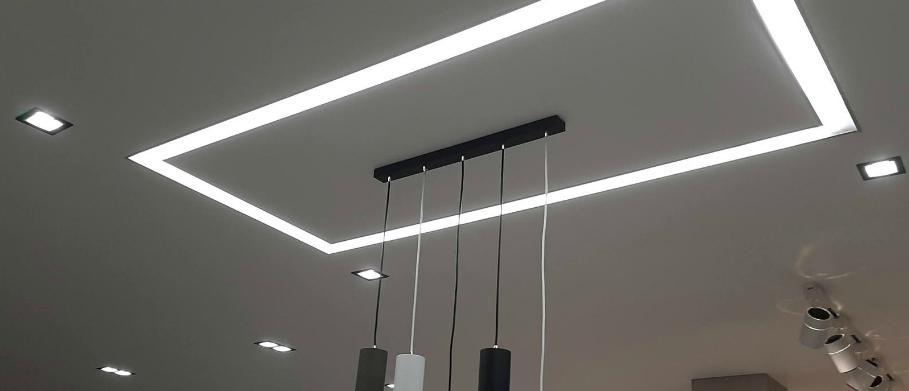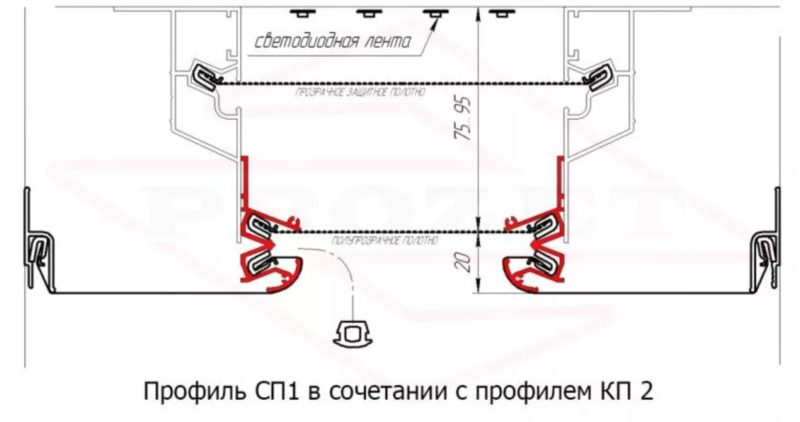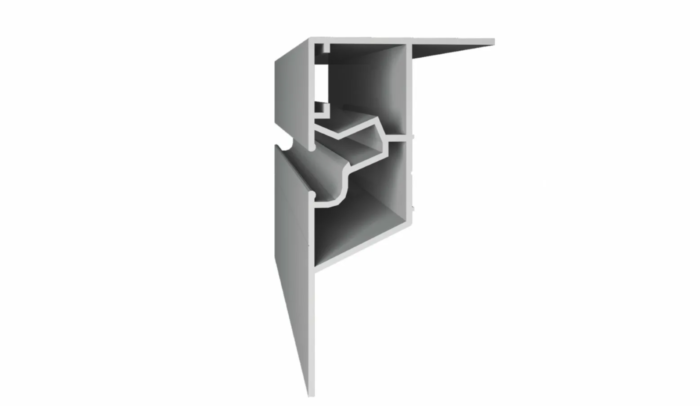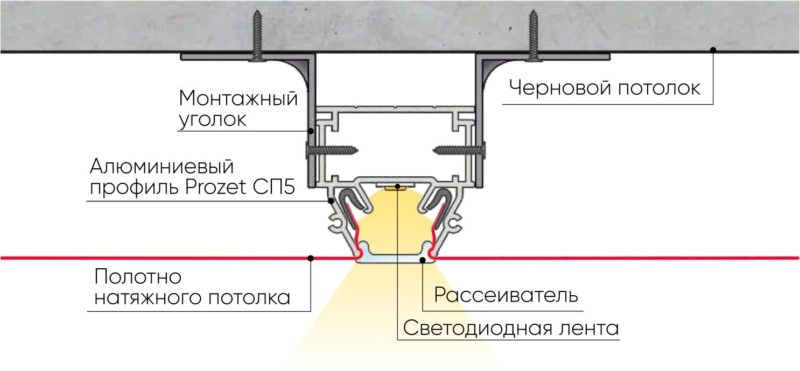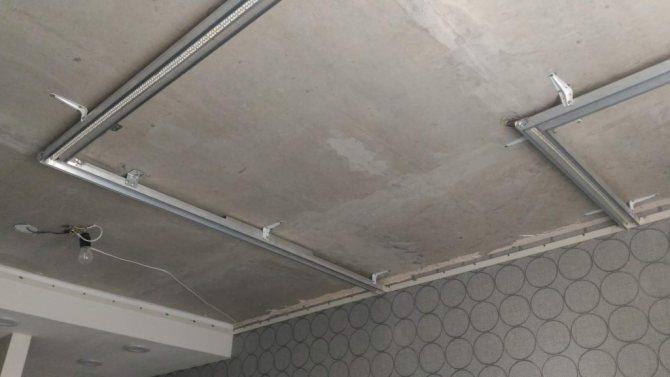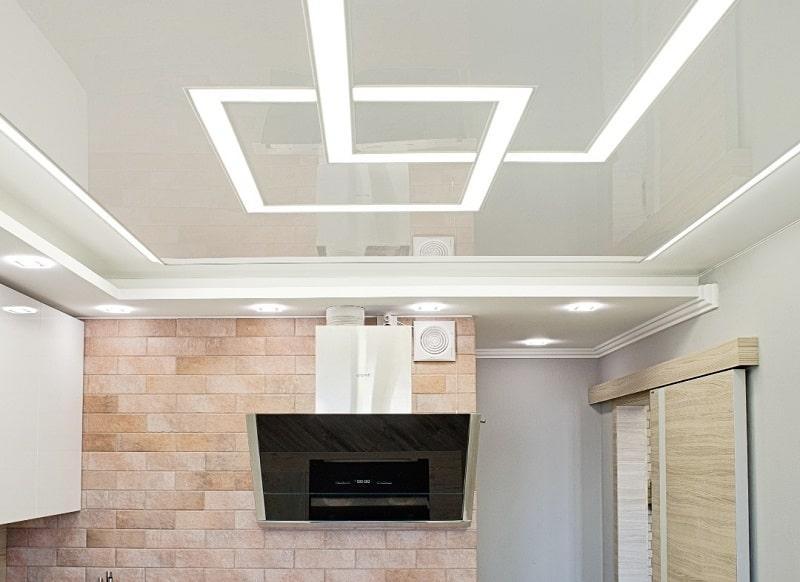Light strips on the stretch ceiling - types and features
Light lines on the stretch ceiling look original and transform the surface. There are different options for implementing this solution, so it's worth looking into them to choose the right one. It can be used both for decoration and as the main lighting, if the width of the line is large, and there are enough light sources installed inside.
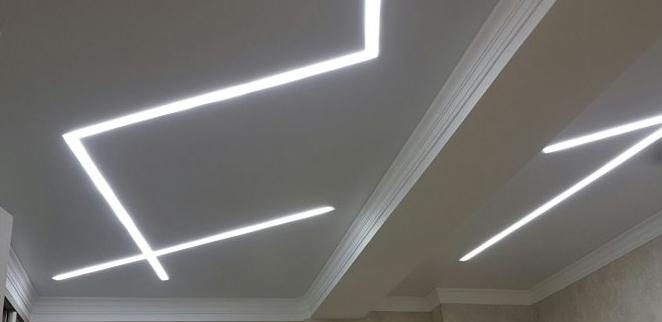
The main features
It is worth noting right away that it is much more difficult to make stripes on the ceiling than to hang a chandelier or put spotlights. Therefore, most often the work is entrusted to professionals. As for the features, they are as follows:
- As a source of light, only LED lamps and strips. This is due to the fact that this option is not strongly heated when working and gives a bright even light without flicker. Another big plus is the long service life, you do not have to get into the design and change the light sources in a couple of years after installation.
- It is easiest to make compositions consisting of straight lines. There can be many options here - from a single straight element to broken and intersecting patterns. It is possible to make lighting with oval contours, but it is much more difficult to implement, so it is rare.
- Lines serve as an original decor, attract attention and are one of the main accents of the furnishings. But if you make them wide, and inside to place light sources of high brightness, you can apply this option and as the main light, the main thing - to comply with the standards of illumination for a particular room.Light strips as a complement to the main light.
- White light is used most often, and can be different - from warm to natural or cold spectrum. The color of the lighting depends not only on the lamps, but also on the characteristics of the light filter or the tension cloth, if the light flow goes through it.
- To change the color of backlighting it is better to put RGB-tape. If high-quality lighting is important, then a single-color version of high power with a frequent arrangement of LEDs is more suitable.
It is worth using only special equipment and profiles to create lines. It is better not to use homemade solutions.
Types of built-in linear lights for a stretch ceiling
You can only use light sources of a certain type. This is due to both safety requirements, and the fact that the luminous lines should be uniform, without darkened areas and highlights. Therefore, only two types are used:
- LED strips.. The best solution, which can be glued on both flat and oval lines. There are many varieties, the characteristics depend on the number of LEDs per linear meter. If you need high brightness, it is worth selecting options with bright diodes arranged in two rows. Typically used monochrome with natural or cool white light, but if you want you can put and colored, the most popular is the illumination of blue and yellow. Due to the diffuser provides an even flow of light.
- T5-T8 LED tube type lamps are also well suited for creating light strips. They can only be used to create even lines, the lamps give a bright uniform light and are often used for basic lighting. The length of one element can be from 50 to 120 cm, this point must be taken into account when planning the lines, otherwise it will not be possible to place the lights normally and in strips will be dark areas.
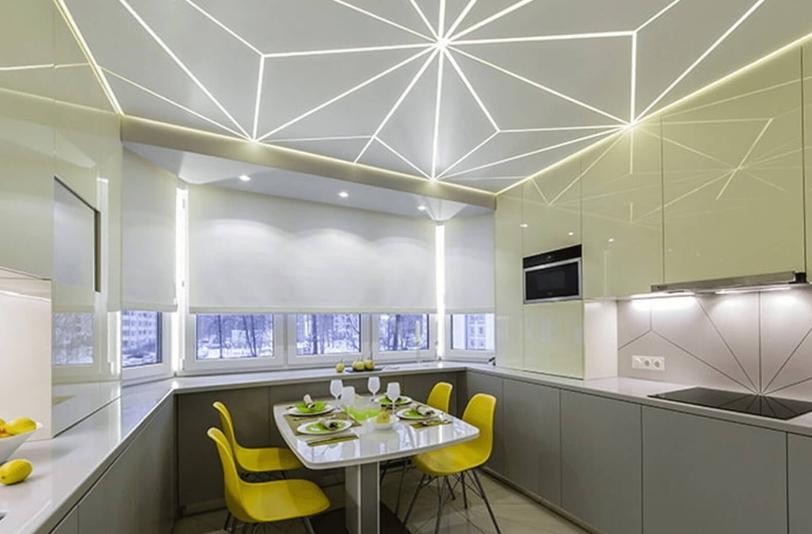
Put halogen and other options is not worth it, as they will not provide the desired quality of light and when working will be strongly heated, which over time will lead to the yellowing of the stretch ceiling.
Profiles to create light lines in the stretch ceiling
To LED lines on the ceiling were perfectly smooth and gave the desired effect, using special profiles. There are many options and each has its own characteristics, it is worth considering the most common solutions:
- SP1 - The universal type, which is used to create a light line, and for the docking of different canvases at one level or in the construction of multi-level systems. Typically, this element is attached to the profile KP2, which is located on the ceiling. The space between the two profiles is closed with translucent film to diffuse light, and the joint is decorated with an oval insert. In this case, the light line is always recessed into the surface, a small depression is not to everyone's liking.KP2 frame profile
- SP2 used much more often, as when installing the light bars with it the surface is obtained evenly. In this case, the profile is attached in the same way as the previous version. The minimum width of the line is 20 mm, and the maximum is not limited, you can make such an indentation that will look best in the room.
- SP5 is a specially designed version to create light lines with a width of 18 mm. It is attached directly to the ceiling surface, which simplifies the work, and the outer part is closed with a special diffuser, which provides uniform lighting.profile design SP5
- KP4075 has a similar design to the previous solution, but it is possible to put the LED strip in two rows to increase the intensity of illumination. The width of the line in this case will be 35 mm, the strip is closed with translucent film. Many craftsmen use this solution to create oval lines by sawing the profile in the right places.
- PC9 - Another similar solution, but its width is already 5 cm. It is used for both straight and oval strips.
- Apply - baguette for ceilings, which can be used for light lines. The "universal" version is 10 cm wide and the "mini" version is 5 cm. Suitable both for backlighting and for multilevel structures and creating a floating ceiling effect.
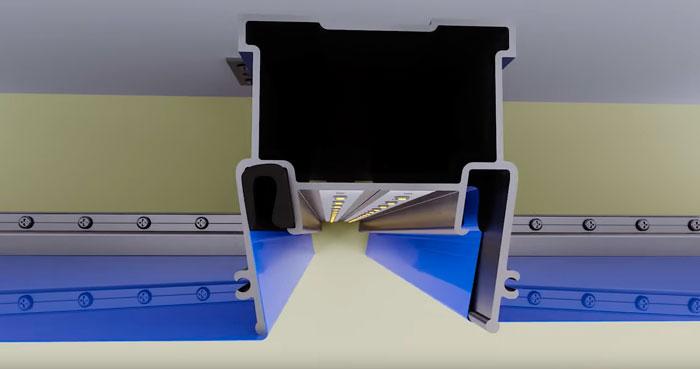
These are the most common types, there may be other brands, but most often they have a similar design.
Installation technology
To make light strips on a suspended ceiling, it is necessary to make a sketch of the suspended structure with the exact dimensions and location of the lines. It is easier to do variants without intersections, they are much easier to assemble and will require less cutting of the profile. Then it is necessary to follow the instructions:
- Making a marking on the surface of the ceiling to see the proportions and location of future lines. At this stage it is possible to make changes.
- If the system includes closed circuits of not very large size, it is better to assemble them in advance and mount them ready on the base. Larger elements are easier to put in place to control the position.
- The wall profiles are installed along the perimeter, they should be used as a reference when determining the level. For orientation, it is easiest to stretch a few cords between opposite walls or use laser equipment, if available.
- If you need to lower the profile, you can use a wooden bar or drywall profile for mounting. But the easiest way is to use hangers.with their help it is easy to adjust the optimal position of light lines, focusing on the level of the wall profile.
- When mounting it is necessary to monitor the accuracy of connections: if the joint will be uneven, the lines will be crooked.Installation must be carried out carefully, checking the position of each element.
- After fixing the profile under the LED strip you need to drill holes in the side dividers to pull the wire through them. LED strip should be cut to size in advance, focusing on the marks, and then solder a piece of copper cable to the contacts of such length that it is enough for further connection.
- Tape neatly glued inside the profile, then pull the cable through the hole and lead it to the location of the transformer. It can be placed either under the suspended ceiling or elsewhere, such as on a cabinet. This will make it easier to replace if the power supply fails, which is usually the first to break. You can put it on the cabinet or in a niche in the wall.
- After wiring, be sure to check that the system is working. If the glow bars turn on and off as they should, you can stretch the ceiling.
If it is necessary connect several pieces of LED strips, use a parallel connection scheme.
What design is suitable for a stretch ceiling with light lines
It is best to apply light strips in modern interiors, as they will fit perfectly into such concepts. As for specific rooms, you need to remember the following:
- In the bathroom, you can make a wide strip around the perimeter to use it as the main lighting. Or come up with a composition that will give enough intense light.
- For corridors and hallways, you can also use this solution as a replacement for traditional lights. In narrow rooms, just put a wide strip in the middle, it is enough for normal lighting.
- In the kitchen you can implement different ideas - from stylish perimeter lighting to lines in the middle. Used for decorative purposes, but modern designers often place a wide strip above the work area to illuminate it.For the kitchen, light lines are great and can replace a traditional chandelier.
- For the hall and living room this option is ideal, with its help it is possible to implement any ideas, the main thing is not to choose too complex designs that will be difficult to assemble.
- In the bedroom, you can use the lines to create dim lighting, which will not turn on the main light unnecessarily.
By the way! It is easier to look for interesting ideas on the Internet.
To reinforce the information we recommend 2 videos.
Video lesson 1: Installing intersecting rhombuses - light lines.
Video lesson 2: Interesting option of light lines crossing from the ceiling to the wall.
Making light lines on a stretch ceiling is much easier than it seems if you understand the process well. The main thing - to buy a profile for this purpose, set it exactly on the surface and properly connect the LED strip.
